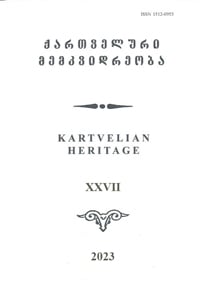CASES OF SYNESIS IN MANUSCRIPT K79
DOI:
https://doi.org/10.52340/PUTK.2023.27.08Keywords:
Georgian manuscripts, Kutaisi State Historical Museum manuscript, K79, synesisAbstract
In old Georgian, number agreement had a formal character, and the expression of grammatical number evolved over the language’s history. Notably, interesting instances of synesis have been confirmed in the K-79 manuscript and other Georgian sources of Lenten Triodion. These examples reveal that the verb form not only corresponds to the form of the noun it agrees with but also takes into account its semantics. Consequently, intriguing patterns of influence on the form emerge as a result of semantics. Examples of synesis are the instances of agreement in number between actants realized by first- and second-person pronouns with the predicate. As is commonly known, these pronouns express plurality lexically and not formally. The examples discussed in the article prove once again that the historical basis of number agreement is undergoing a change. The formal principle, which was the norm in the Old Georgian Language, is gradually being replaced by the semantic principle.

